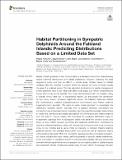Files in this item
Habitat partitioning in sympatric delphinids around the Falkland Islands : predicting distributions based on a limited data set
Item metadata
| dc.contributor.author | Franchini, Filippo Luciano Charly | |
| dc.contributor.author | Smout, Sophie Caroline | |
| dc.contributor.author | Blight, Clint | |
| dc.contributor.author | Boehme, Lars | |
| dc.contributor.author | Munro, Grant | |
| dc.contributor.author | Costa, Marina | |
| dc.contributor.author | Heinrich, Sonja | |
| dc.date.accessioned | 2020-05-05T15:30:03Z | |
| dc.date.available | 2020-05-05T15:30:03Z | |
| dc.date.issued | 2020-04-30 | |
| dc.identifier | 267525191 | |
| dc.identifier | 35197859-8732-461f-a303-cfa716e078c4 | |
| dc.identifier | 000529897000001 | |
| dc.identifier | 85084738686 | |
| dc.identifier.citation | Franchini , F L C , Smout , S C , Blight , C , Boehme , L , Munro , G , Costa , M & Heinrich , S 2020 , ' Habitat partitioning in sympatric delphinids around the Falkland Islands : predicting distributions based on a limited data set ' , Frontiers in Marine Science , vol. 7 , 277 . https://doi.org/10.3389/fmars.2020.00277 | en |
| dc.identifier.issn | 2296-7745 | |
| dc.identifier.other | ORCID: /0000-0003-4752-0348/work/73700679 | |
| dc.identifier.other | ORCID: /0000-0002-6069-6682/work/73701878 | |
| dc.identifier.other | ORCID: /0000-0002-3481-7428/work/91340776 | |
| dc.identifier.uri | https://hdl.handle.net/10023/19885 | |
| dc.description | Funding: The field work was funded by the Darwin Initiative UK Overseas Territories Challenge Fund Project “Inshore Cetaceans of the Falkland Islands” (Project Ref: EIDCF019, administered jointly by Falklands Conservation & Mr Grant Munro), and Darwin Plus: Overseas Territories Environment and Climate Fund Project “Dolphins of the kelp: Data priorities for Falkland’s inshore cetaceans” (Project Ref: DPLUS042, administered by SAERI). | en |
| dc.description.abstract | Spatial modelling based on line transect data is a standard method for characterising marine mammal distributions and habitat preference. However, collecting the data required is costly and may be difficult in remote areas. Models based on habitat variables offer the potential to predict where the species will occur in areas outside the area of a localised survey. This has important implications for spatial management where decisions have to be made that affect wide areas over which comprehensive survey efforts may not be feasible. This study demonstrates that it is possible, using a spatially limited data set, to characterise habitat use and predict the distribution of two poorly known sympatric delphinids around the Falkland (Malvinas) Islands (FI), Commerson’s dolphins (Cephalorhynchus commersonii) and Peale’s dolphins (Lagenorhynchus australis). We used a Hurdle model approach to investigate the relationship between dolphin sightings (from a spatially restricted boat-based line transect survey) and environmental covariates. We then used the modelled relationships to predict the distribution and relative abundance of Commerson’s and Peale’s dolphins over the entire FI inshore waters. We compared the predicted distribution maps to independent sightings from a subsequent island-wide aerial line transect survey, and found a close match between predicted and observed distributions. Commerson’s dolphins preferred nearshore waters with strong tidal mixing and were most numerous close to river mouths and in upper inlets or channels. In contrast, Peale’s dolphins preferred deeper, well-stratified areas further from shore as well as nearshore waters with extensive kelp beds. While the two dolphin species are often considered sympatric, our results indicate fine-scale habitat partitioning based on specific habitat preferences, which is important to consider in further studies and marine spatial planning. We provide several methodological refinements to prepare transect sighting data for spatial analysis and implement Hurdle models more easily using the new “dshm” R-package. We also show the usefulness of such refinements applied to a carefully chosen spatially limited dataset as a cost-effective approach to elucidating species distribution patterns. Our methodology and software implementations can be easily applied to transect survey data of other marine and terrestrial taxa. | |
| dc.format.extent | 6976092 | |
| dc.language.iso | eng | |
| dc.relation.ispartof | Frontiers in Marine Science | en |
| dc.subject | Falkland Islands | en |
| dc.subject | Habitat partitioning | en |
| dc.subject | Hurdle model | en |
| dc.subject | Line transect survey | en |
| dc.subject | Predictive species distribution modelling | en |
| dc.subject | Commerson’s dolphin | en |
| dc.subject | Peale’s dolphin | en |
| dc.subject | GC Oceanography | en |
| dc.subject | QH301 Biology | en |
| dc.subject | DAS | en |
| dc.subject | SDG 14 - Life Below Water | en |
| dc.subject.lcc | GC | en |
| dc.subject.lcc | QH301 | en |
| dc.title | Habitat partitioning in sympatric delphinids around the Falkland Islands : predicting distributions based on a limited data set | en |
| dc.type | Journal article | en |
| dc.contributor.institution | University of St Andrews. Statistics | en |
| dc.contributor.institution | University of St Andrews. Coastal Resources Management Group | en |
| dc.contributor.institution | University of St Andrews. School of Biology | en |
| dc.contributor.institution | University of St Andrews. Sea Mammal Research Unit | en |
| dc.contributor.institution | University of St Andrews. Scottish Oceans Institute | en |
| dc.contributor.institution | University of St Andrews. Centre for Research into Ecological & Environmental Modelling | en |
| dc.contributor.institution | University of St Andrews. Marine Alliance for Science & Technology Scotland | en |
| dc.identifier.doi | 10.3389/fmars.2020.00277 | |
| dc.description.status | Peer reviewed | en |
This item appears in the following Collection(s)
Items in the St Andrews Research Repository are protected by copyright, with all rights reserved, unless otherwise indicated.

